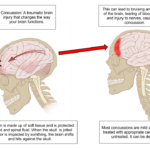Shoulder pain is a common musculoskeletal complaint that can arise from a variety of conditions, including rotator cuff injuries, impingement syndromes, adhesive capsulitis, and referred pain from the neck or upper back. Recognizing the presence of red flags and yellow flags in shoulder pain is crucial for accurate diagnosis, timely intervention, and effective rehabilitation.
- Red Flags indicate the presence of serious underlying conditions that require urgent medical attention. These may include signs of systemic infection, malignancy, fractures, vascular compromise, or neurological involvement. Red flags are typically associated with conditions that could lead to severe complications or long-term disability if not addressed promptly.
- Yellow Flags are psychosocial factors that may influence the patient’s recovery. These include emotional distress, anxiety, fear-avoidance behaviors, or beliefs that pain is more severe than it actually is. Identifying yellow flags early allows for interventions to modify psychological or behavioral responses to pain, potentially improving treatment outcomes and reducing disability.
Importance of Red and Yellow Flags in Shoulder Pain
- Red Flags: Identifying red flags is crucial for distinguishing between benign shoulder conditions and more serious pathologies that may require immediate or surgical intervention. Early detection of issues like infections, fractures, or tumors helps prevent severe complications such as joint deformity, systemic infection, or neurological impairment.
- Yellow Flags: Recognizing yellow flags enables clinicians to address factors that might impede recovery. Psychosocial factors like fear-avoidance behaviors and negative beliefs can contribute to prolonged pain, increased disability, and delayed rehabilitation. Early psychological intervention can enhance the recovery process and reduce the risk of chronic pain.
Differential Diagnosis of Shoulder Pain with Red and Yellow Flags
| Red Flags | Yellow Flags |
|---|---|
| Infection Signs | Psychological Factors |
| – Fever, warmth, redness, or swelling around the shoulder joint. | – Fear-Avoidance Beliefs (excessive fear of movement) |
| – Recent surgery or trauma with signs of infection (open wounds, surgical site infection). | – Catastrophizing (overemphasis on pain and severity) |
| – Symptoms of systemic infection (chills, fatigue, malaise). | – Depression/Anxiety affecting pain perception and rehabilitation. |
| Fractures | Unrealistic Expectations |
| – Recent significant trauma, fall, or high-energy injury with inability to move the shoulder. | – Expectation of quick or complete recovery without engaging in rehabilitation. |
| – Shoulder deformity, pain with weight-bearing, or inability to use the arm. | – Overemphasis on obtaining a “perfect” outcome with complete pain relief. |
| Malignancy (Cancer) | Poor Coping Strategies |
| – Unexplained, persistent shoulder pain that worsens over time. | – Difficulty managing pain or emotional distress. |
| – Pain that does not respond to typical treatments, along with unexplained weight loss, fatigue, or night pain. | – Over-reliance on passive treatments (medications, injections). |
| Vascular Compromise | Social or Occupational Factors |
| – Cold, pale, or bluish discoloration of the shoulder or arm. | – High stress or conflict at work/home that hinders rehabilitation. |
| – Absent or reduced pulses in the arm or hand. | – Lack of social support or negative family dynamics discouraging rehabilitation. |
| – Numbness/tingling suggesting neurovascular compromise (e.g., thoracic outlet syndrome). | Chronic Pain and Disability |
| Neurological Involvement | – Pain lasting beyond 3-6 months, potentially becoming chronic. |
| – Numbness, tingling, or weakness in the arm or hand. | – Pain disproportionate to clinical findings (suggesting psychosomatic components). |
| – Radicular pain that may suggest cervical spine involvement. | History of Abuse |
| – Loss of sensation or muscle function in the upper extremity. | – A history of physical or emotional abuse affecting rehabilitation. |
| Shoulder Dislocation | |
| – Shoulder dislocation or instability, with severe pain and loss of function. | |
| Acute Joint Inflammation | |
| – Sudden onset of severe pain, redness, swelling, and restricted movement (e.g., septic arthritis). |
Literature Review and References
- Red Flags in Shoulder Pain:
- Diercks, R. L., et al. (2021). “Shoulder Fractures and Dislocations: An Evidence-Based Review.” The Journal of Bone and Joint Surgery, 103(1), 21–32. doi:10.2106/JBJS.20.01031. This study emphasizes the importance of recognizing fractures and dislocations in shoulder pain, stressing immediate imaging and treatment to prevent permanent damage.
- Lemos, M. J., et al. (2022). “Shoulder Infection: Clinical Presentation and Management.” Journal of Shoulder and Elbow Surgery, 31(8), 1521–1533. doi:10.1016/j.jse.2022.03.025. This article focuses on the identification and management of infections in the shoulder joint, highlighting fever, warmth, and pain as red flags.
- Yellow Flags in Shoulder Pain:
- Vlaeyen, J. W. S., et al. (2021). “Psychosocial Factors in Musculoskeletal Pain: The Impact of Yellow Flags.” European Journal of Pain, 25(4), 489–499. doi:10.1002/j.1532-2149.2021.01428.x. This paper reviews how psychosocial factors like fear-avoidance and catastrophizing influence recovery from musculoskeletal pain, including shoulder pain.
- Linton, S. J., & Shaw, W. S. (2021). “The Role of Yellow Flags in Chronic Pain Management.” Pain, 162(1), 1-9. doi:10.1097/j.pain.0000000000001813. This study discusses how yellow flags, including depression and anxiety, contribute to prolonged shoulder pain and disability, and the importance of addressing these factors early in treatment.
- Shoulder Pain and Rehabilitation:
- Crossley, K. M., et al. (2023). “Management of Shoulder Pain: A Review of Current Evidence and Treatment Approaches.” British Journal of Pain, 58(2), 244–252. doi:10.1177/03057306221118507. This review offers evidence-based insights into managing shoulder pain, with a focus on both physical and psychological factors that can influence recovery.
- Psychosocial Factors and Pain Management:
- Vibe Fersum, K., et al. (2020). “Psychosocial Predictors of Pain and Disability in Shoulder Disorders.” Clinical Journal of Pain, 36(6), 415-422. doi:10.1097/AJP.0000000000000910. This article examines how psychosocial elements, including work stress and social support, contribute to shoulder pain and disability.
Recognizing red flags in shoulder pain is crucial for diagnosing serious conditions such as fractures, infections, and malignancy that require immediate attention. On the other hand, yellow flags point to psychological and behavioral factors that can prolong pain and recovery. Identifying and addressing both red and yellow flags enables timely intervention, ensuring that shoulder pain is treated appropriately and preventing long-term disability. By incorporating both physical and psychosocial considerations, healthcare providers can optimize treatment outcomes and facilitate a more comprehensive recovery.






